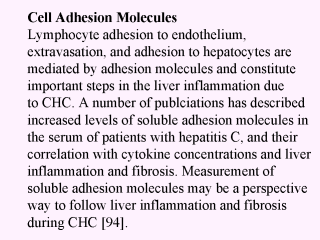 |
Liver necroinflammation
was found to be more closely related to soluble intercellular adhesion molecule (sICAM-1,
sCD54) (r = 0.54, P = 0.0000) than to vascular cell adhesion molecule (sVCAM-1, sCD106) (r
= 0.32, P = 0.02). Fibrosis, both as serum pIIIP and histological scoring, was, however,
clearly related to sVCAM-1 (1071+/-291 in patients who scored 0-2 vs. 1870+/-458 in
patients who scored 3-4). Severe fibrosis was never found below a sVCAM-1 cut-off
threshold of 1300 ng/mL. Levels of both adhesins did not correlate with viraemia and were
comparable among 1b and non-1b genotypes. Sustained response to interferon was
significantly related to low viraemia (P= 0.03), non-lb type (P = 0.04) and low sICAM-1 (P
= 0.04), but not toć sVCAM-1. On finalizing therapy, patients with normal transaminases
had reduced sICAM-1 (P = 0.0005), but not sVCAM-1 levels (52 pts) [95]. Both low sVCAM-1
and PIIIP serum concentrations were strictly linked, suggesting that measuring sVCAM-1
could give information on the degree of liver fibroplasia. Soluble ICAM-1 and E-selectin
(sCD62E) correlated with TNF-alpha and AST levels. Kaplanski et al. have also correlated sICAM-1 with
liver lobular inflammation, and sVCAM-1, sCD62E, and IL-8 with liver fibrosis [94]. While
a decrease in ICAM-1 levels during IFN + ribavirin treatment is associated with response
to therapy, monitoring of VCAM-1 during antiviral therapy does not differentiate between
responders and non-responders [78]. |
